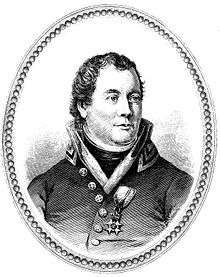Georg Adlersparre
| Count Georg Adlersparre | |
|---|---|
 | |
| Born |
28 March 1760 Hovermo (now part of Berg Municipality, Jämtland County) |
| Died |
23 September 1835 (aged 75) Kristinehamn Municipality, Värmland |
| Allegiance | Sweden |
| Rank | Major General |
| Battles/wars | Russo-Swedish War |
| Other work | County governor of Skaraborg County, 1810-1824 |
Count Georg Adlersparre (March 28, 1760 – September 23, 1835) was a Swedish army commander, politician and writer.
Biography
Adlersparre was born in Hovermo (now a part of Berg Municipality, Jämtland County). Having entered the army at the age of 15, he received from King Gustav III, in 1791, a secret commission to excite the Norwegians to rebellion. After the death of the king, he left the army and devoted himself to science. In 1797-1801, he published a periodical läsing i blandade Ämnen,[1] and the liberal spirit in which he conducted it brought upon him the suspicions of the government.[2]
In 1802, he was elected a member of the Royal Swedish Academy of Sciences.[3]
In 1809 he joined the military campaign against Russia,[1] and he unexpectedly received the command of a part of the so-called western army, and was shortly afterwards promoted to the post of lieutenant-colonel. [2] He was engaged in the conspiracy[2] with Carl Johan Adlercreutz against Gustav IV Adolf and triggered the revolution of 1809 by marching with his army to Stockholm.[4] He received the thanks of the Riksdag and he was granted several honors that eventually included the title of count; he was governor of Skaraborg County from 1810 until 1824 when he resigned.[1] Having received the command of the army from the new government, he was commissioned to excite the Norwegians against Denmark, in which he was unsuccessful.[2]
After the sudden death of the crown prince he retired from public life, but still continued to receive marks of royal favor, notwithstanding the liberality of his sentiments.[2] In 1831 he was involved in a controversy for publishing secret state documents and his private correspondence with various Swedish princes, actions for which he remained unrepentant (he continued publishing more papers).[1] In 1824 he retired from public life and took stable residence in Gustafsvik Manor in Kristinehamn Municipality, Värmland, where he died in 1835.[5]
Family
In 1809 he married Lovisa Magdalena Linroth (April 20, 1784 – November 8, 1866 Kristinehamn Municipality, Värmland). They had four children:[6]
- Carl August Adlersparre (1810-1862), distinguished himself as a poet and an historian.[7][1]
- Lovisa Maria Adlersparre (1814-1837)
- Georg Axel Adlersparre (1816-1889)
- Rudolf Adlersparre (1819-1908)
Notes
- 1 2 3 4 5 Ripley & Dana 1879, p. 123.
- 1 2 3 4 5 Ripley & Dana 1863, p. 128.
- ↑ Members of the Royal Swedish Academy of Sciences
- ↑ Meijer 1904, p. 179.
- ↑ Meijer 1904, p. 180.
- ↑ (Swedish) Riksarkivet
- ↑ (Swedish) 1809 års revolution och dess män (The 1809 revolution and its men), 2 vol., Stockholm, 1849, A. Bonniers Föorlag, (Swedish) 1809 Och 1810: Tidstaflor, 3 vol., Stockholm, 1850, A. Bonniers Föorlag and (Swedish) Anteckningar om bortgångne samtida, 3 vol., Stockholm 1860-1862, A. Bonniers Föorlag
References
 This article incorporates text from a work in the public domain: Ripley, George; Dana, Charles A., eds. (1863). "Adlersparre, Georg". The New American Cyclopedia. 1. p. 128–129.
This article incorporates text from a work in the public domain: Ripley, George; Dana, Charles A., eds. (1863). "Adlersparre, Georg". The New American Cyclopedia. 1. p. 128–129. This article incorporates text from a publication now in the public domain: Ripley, George; Dana, Charles A., eds. (1879). "Adlersparre. I. Georg". The American Cyclopædia. 1. p. 123.
This article incorporates text from a publication now in the public domain: Ripley, George; Dana, Charles A., eds. (1879). "Adlersparre. I. Georg". The American Cyclopædia. 1. p. 123.
- Meijer, Bernhard, ed. (1904). Nordisk Familjebok Konversationslexikon och Realencyklopedi (in Swedish). 1 A-Armati. Stockholm: Nordisk familjeboks förlags aktiebolag. pp. 179–180. Retrieved 2014-01-18.
External links
-
 Media related to Georg Adlersparre at Wikimedia Commons
Media related to Georg Adlersparre at Wikimedia Commons - "Nordisk familjebok (1876-1926)". Project Runeberg. Retrieved 19 January 2014.